Tai Shani ‘The Neon Hieroglyph’
In conversation with Hana Noorali and Lynton Talbot
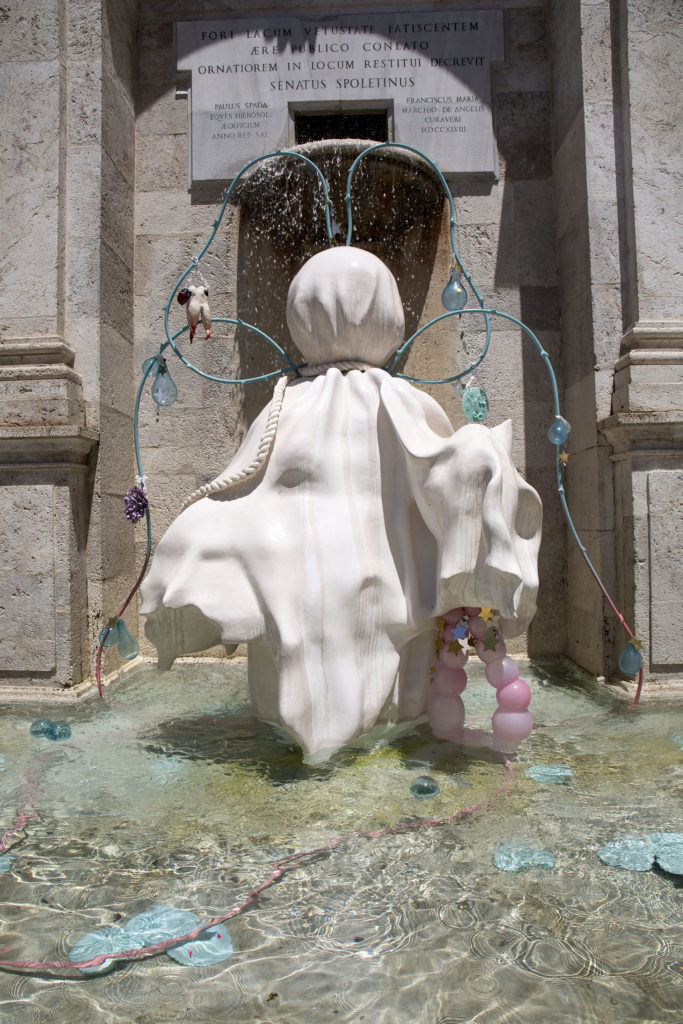
Commissioned by Carla Fendi Foundation and the Mahler & LeWitt Studios
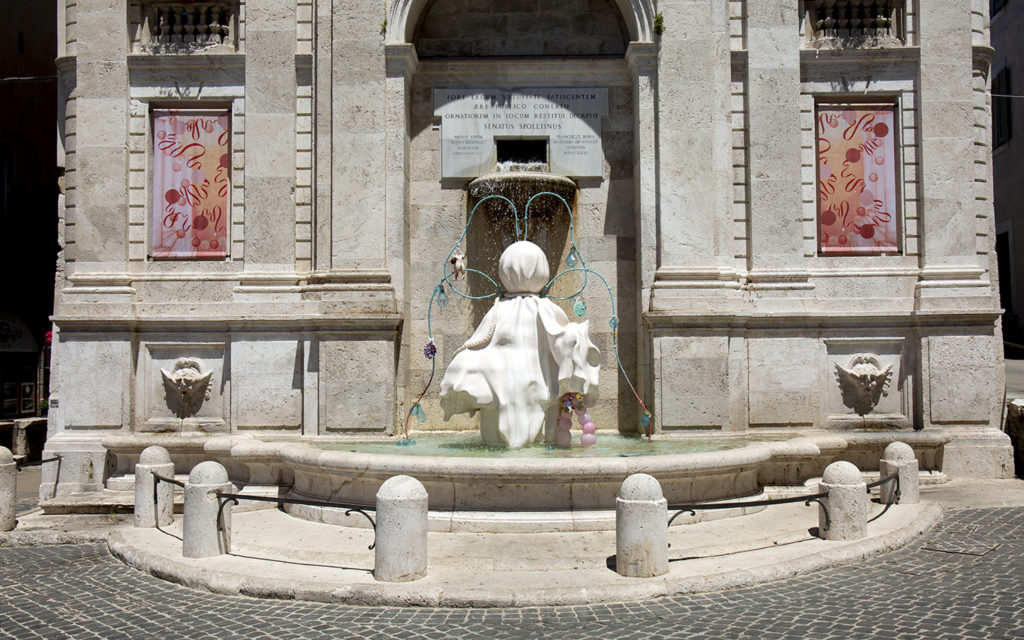
Commissioned by Carla Fendi Foundation and the Mahler & LeWitt Studios
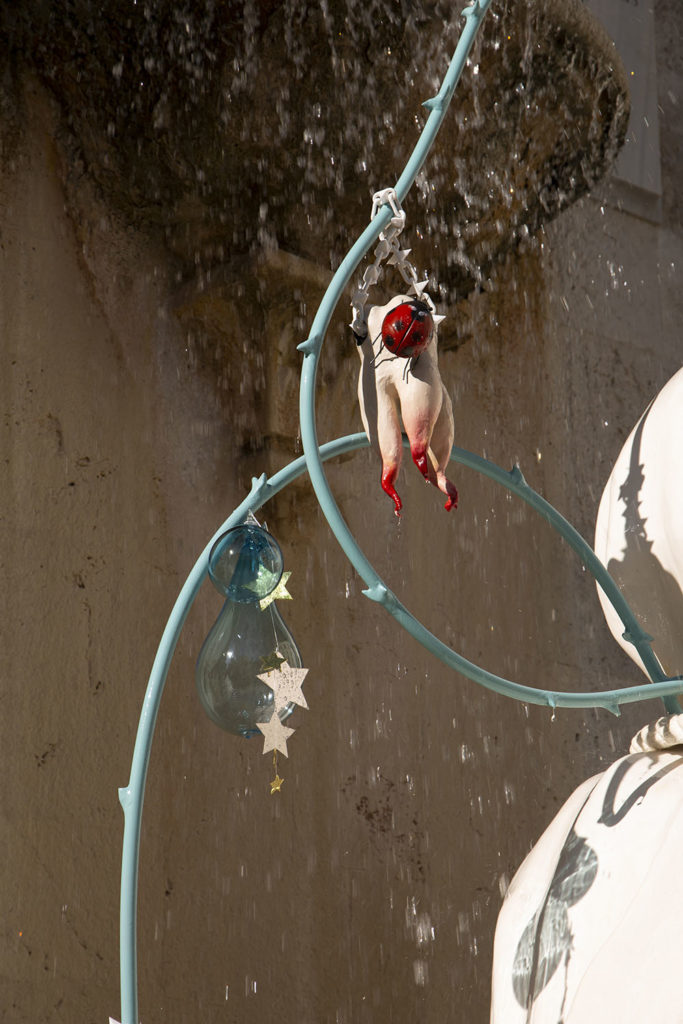
Commissioned by Carla Fendi Foundation and the Mahler & LeWitt Studios
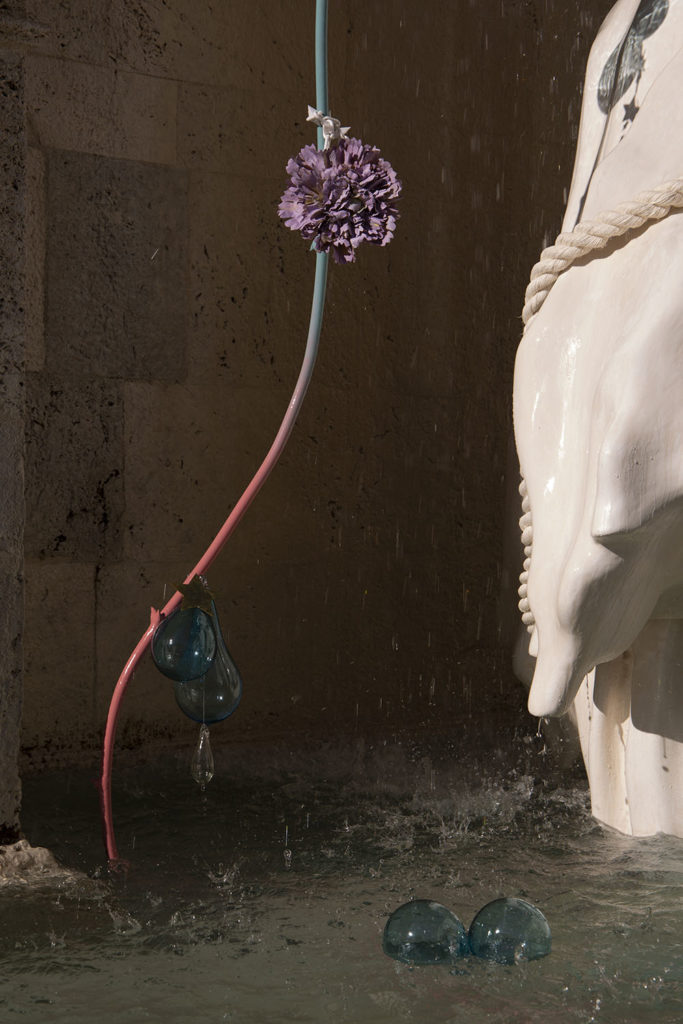
Commissioned by Carla Fendi Foundation and the Mahler & LeWitt Studios
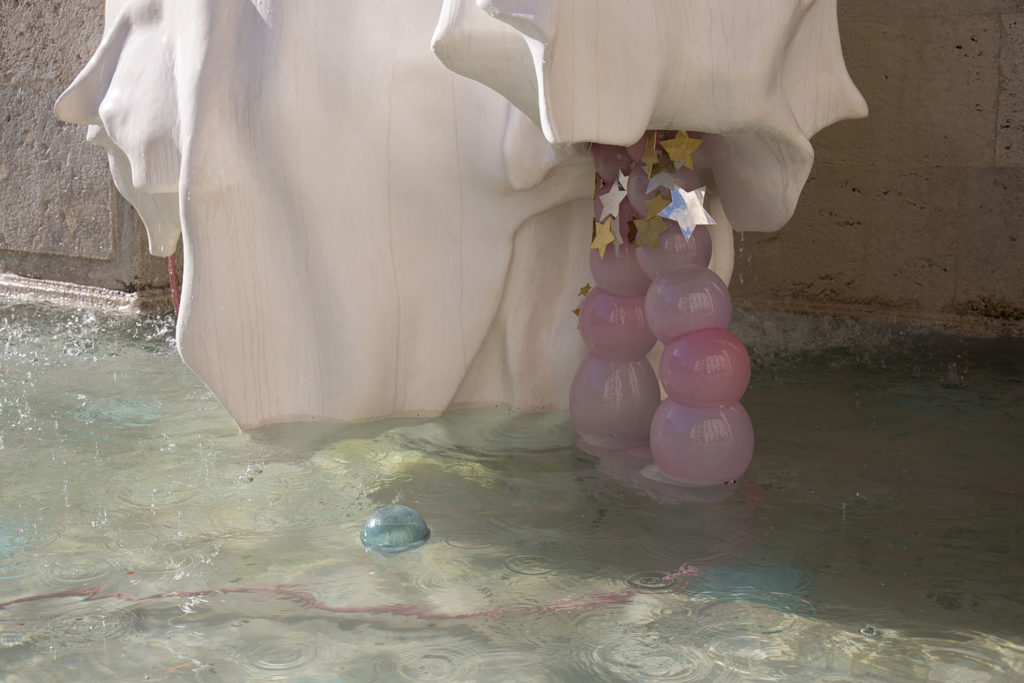
Commissioned by Carla Fendi Foundation and the Mahler & LeWitt Studios
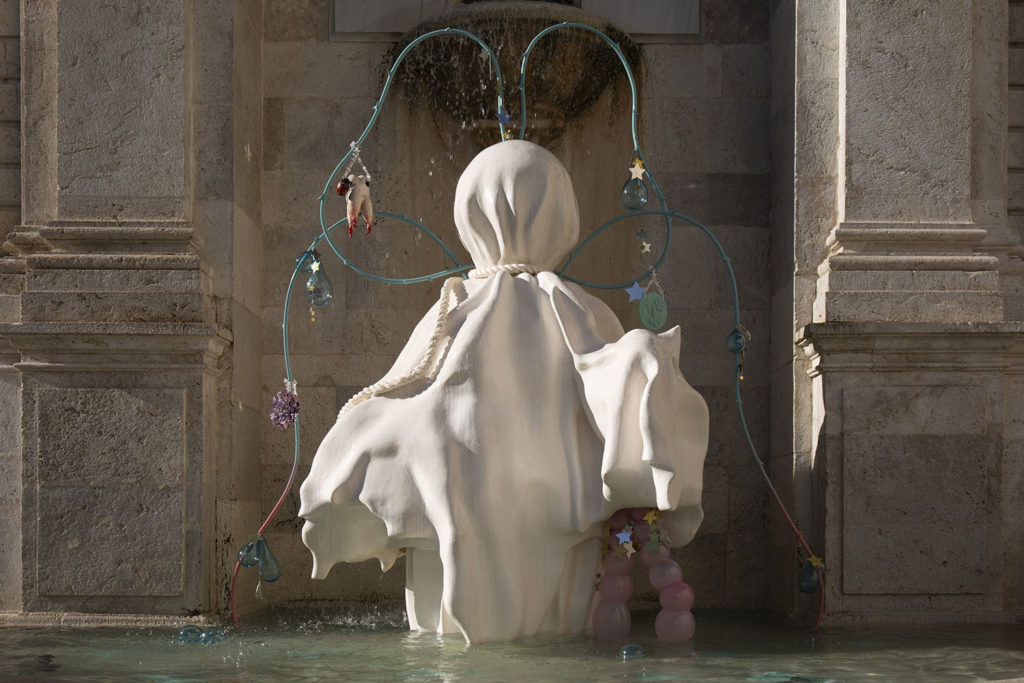
Commissioned by Carla Fendi Foundation and the Mahler & LeWitt Studios
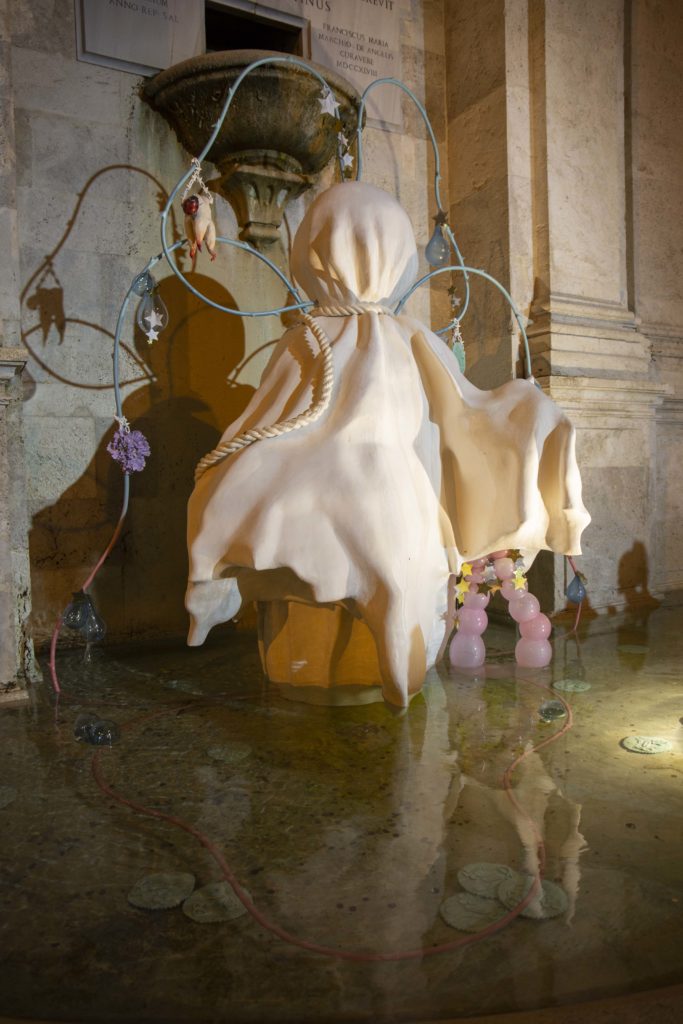
Commissioned by Carla Fendi Foundation and the Mahler & LeWitt Studios
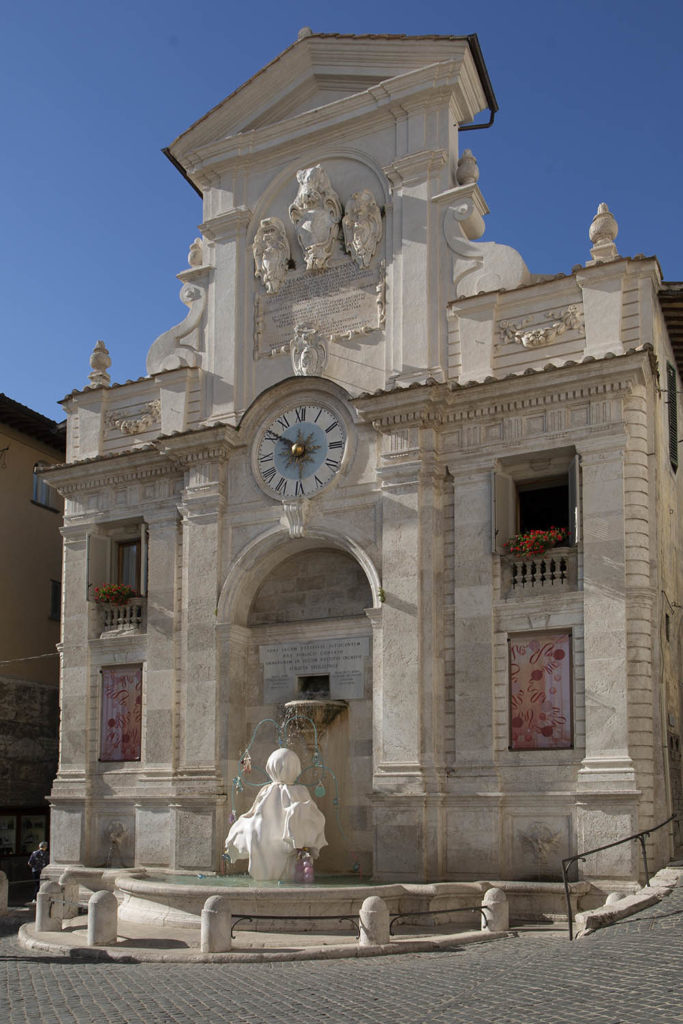
Commissioned by Carla Fendi Foundation and the Mahler & LeWitt Studios
Festival dei Due Mondi, Spoleto
25 June – 12 July, 2021
La Fontana di Piazza del Mercato and Palazzo Collicola – Galleria d’Arte Moderna G. Carandente
…the sun is the ghost that haunts the night…
Produced by the Carla Fendi Foundation and the Mahler & LeWitt Studios, for the 64th edition of the Festival dei Due Mondi, Tai Shani presented a site-specific sculpture installation inspired by her research into psychedelics, feminism and myth. The Neon Hieroglyph installation for Spoleto was sited on the Fontana di Piazza Mercato in the centre of the old town, at one end of what was once the Roman Forum. Shani’s installation is a portrayal of an enigmatic ghost, coiled in lucky charms and tears. The Neon Hieroglyph is a series of poetic considerations on the history of ergot, a fungus from which LSD is derived. Read more about the project here>>
Former Mahler & LeWitt Studios curators in residence, Hana Noorali and Lynton Talbot, discuss The Neon Hieroglyph with Shani:
Lynton Talbot: It seems as though ghosts pervade the whole of The Neon Hieroglyph (2021). They’re there from the outset, all the way through to the end. The work is bookended by the spectral. One of the first things that struck me in the film is the character who says at the start, “the dead can’t hurt you, but the living almost certainly will.” And that “the sun is a ghost that haunts the night”. So, you begin in a crypt, under the earth’s ground and end by exiting the solar system entirely, reminded via a call-back that the sun is still haunting the night. The film takes you through all these levels, from the material to the spectral, from the micro out to the macro, from the molecular to the cosmic. I realised that the idea of haunting, even on a personal level, was elevated to a special status throughout this journey. Haunting is not frightening or harmful, but about a privileged access to those different levels of experience and being afforded a distanced view on them as a kind of positive position on things. Haunting pervades the whole film. I guess the ghost arriving in Spoleto has something to do with that as well?
Tai Shani: I think that is a nice reading of the work and I have been thinking about why there are so many ghosts in the project. One of the things that I was thinking about when I started writing The Neon Hieroglyph was how history is a plateau of almost infinite data through which we create ideological trajectories. There is a kind of consensus history which is patriarchal and ideas around borders and conquering are privileged in that narrative.
In my previous project, DC Productions (2014-2019), I was looking at how all this data can be structured into an alternate narrative that has a different ideological framework around it. When I began thinking about the history of Ergot, which is little-known about, whilst not being a hidden history by any means – it just doesn’t really have a history, I saw these disparate manifestations of phenomena. For example, people having dancing plagues and certain theories asking whether the psychoactive agent was used in certain ritualistic practices.
So, there are these kind of touch points that you can thread together, creating a history. I don’t want to go into hauntological discourse too much, because I’m not particularly interested in that, but I do think we live amongst ghosts, don’t we? We are continually living with the detritus of history and the ghosts that surround us. Looking at discourses around statues of people representing violent histories: they become ambient ghosts of violence, which people don’t even necessarily know, but which act as reminders.
Everything we pick up is collaborative. Any object you pick up, any kind of medicine you take, any book you read. It’s a process of trans-temporal collaboration. I think that we’re very much embedded, as living beings, within a kind of infrastructure of ghosts as well. I think this is particularly relevant when thinking about reclaimed histories. I know that Silvia Federici has been cancelled, but one of the reasons people like her reading of witches, and why it’s such an interesting thesis, is that she applies a Marxist materialist reading onto a subject that seems as though it’s within the realms of the supernatural, or at least on the threshold between an immaterial and material world.
Think of witches and their legacy. There are so many things that have no kind of structured legacy. I began thinking what it could be to build an affective mausoleum for these psychedelic witches, for ideas that never really managed to create traction.
So, for example, as I mentioned earlier, these moments of the dancing plague. It’s, so interesting that there were entire villages that would have been under the influence of a psychedelic for days. There hasn’t been an unpacking of those histories, or any teasing out, so that they extend into a narrative. They only exist as pockets of phenomena. In The Neon Hieroglyph I am attempting to create an affective space for that.
With Spoleto specifically, and on a more personal note; my dad died in very tragic circumstances, very near to the city. I’m haunted by that. I’m haunted by his life, his actions and also his death. It made sense for me to address that as a secular person who’s trying to discover or approach some form of spirituality that feels authentic to me. I don’t find it acceptable that we’re just here. I don’t believe in an afterlife. I don’t have a structured belief system at all, but I am searching for something definitely. There are moments – fleeting glimpses – that are ineffable, and I often feel like a ghost myself.
Going back and revisiting Umbria, in Italy, makes me very much a ghost. It puts me in a crosshair target of a past self and a present self. Without continuity, it makes you feel like you’re either haunting or being haunted by yourself.
Lynton: Your speaking of ghosts has confirmed something that I was also thinking about, watching the film. I was thinking about the idea of the ghost as a praxis or a methodology. You said, “I sometimes feel like a ghost”; I can really see that in the film as well. I’m not necessarily talking specifically about your Dad, but this relationship to Umbria and Spoleto and the idea that the ghost is not necessarily just a specter, but a way to be, a way to do things. I feel like in the films there’s always the idea that you are floating above things and have a distanced perspective. The ghost as a material entity can overcome earthly constrictions, it is given access or agency and it can transcend boundaries, traverse different temporalities, and in doing so can retell the stories from a different view. The ghost becomes a vehicle by which we tread a different path through time.
Tai: The structure of the film is based on an incredible book by Olaf Stapledon called Starmaker. The story begins with the protagonist travelling through the core of the earth, coming out of the other side, then going into the galaxy and then into other galaxies and encountering different civilisations and species. I started writing my film thinking about that structure and I reference the book in the text as well. The structure is going from the cellular out to the galactic. Episode 7 of The Neon Hieroglyph is about that moment of levitating above the Earth and how our imagination is informed by the technological vernacular that we have around us and how drone photography has become so ubiquitous and this bird’s eye view is something that now exists. I dream of that sometimes, it’s a kind of visual language that now just exists in my mind, which wouldn’t have 10 years ago. I was thinking a lot about that innovation or how the accessibility of it has created this new way of thinking about the world.
People who make computer generation of snow falling, the ways we can create random patterns on purpose is really hard to do. Or when people paint flowers there’s always this difficulty to kind of get the organic movement. But what I find beautiful is when you look at cities from the perspective of a bird’s eye view, there’s this incredible kind of topography that exists that wasn’t designed on purpose. They almost look like they emerged organically, but as though they were auto generated. I really love how this looks and the idea that suddenly technology gives you this alternate view.
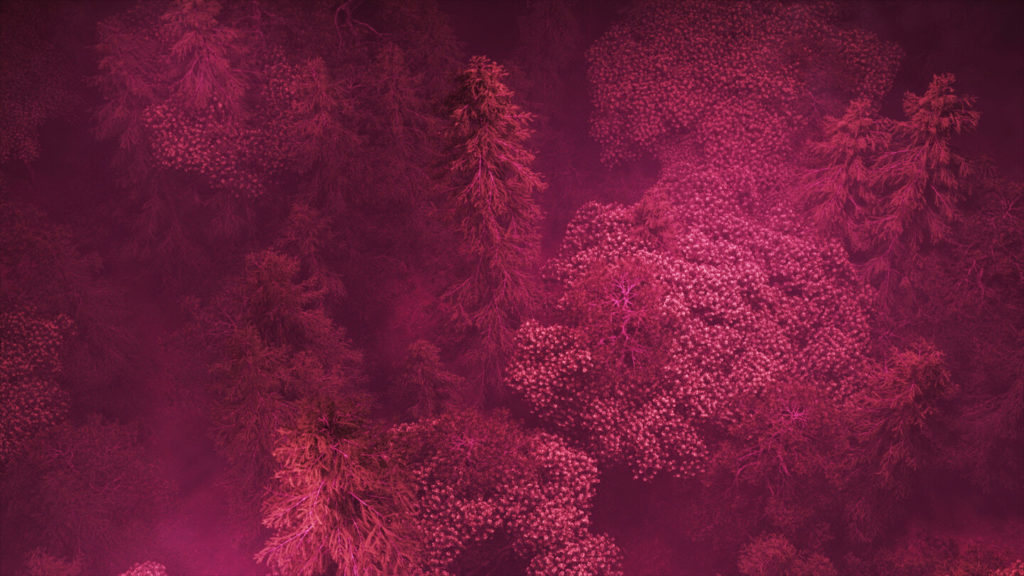
Lynton: I suppose these top down views give you a topology of what architects might call desire lines, things that are not planned.
Tai: Exactly. The idea of imagining the future is that you always have this sense of a cathartic vista where everything is new, and it never has that cultural drag or a historical drag. For example, buildings that were built in the 1900s that are not extraordinary, just a row of terraced houses that will probably be around for a really long time, alongside futuristic buildings. I think the other thing that you see with a bird’s eye view is this time, you know, almost like a strange time map where you have these different eras that sit alongside each other. I think it’s really interesting how that suddenly exists.
Lynton: Hito Steyerl wrote an essay titled In Free Fall: A Thought Experiment on Vertical Perspective (2011) that said something along the lines of the history of modernity is the slow diminishing of the horizon line, because it’s a sort of slow inversion from looking forwards, to looking from above. Steyerl cited William Turner as being the first painter who was interested in getting rid of the horizon by tying himself to a mast and painting scenes in a storm so you couldn’t see the perspective. You’re bombarded by this fog of modernity and chaos. There’s been a slow process of turning it this way: where everything’s now orientated from the top down, which induces a kind of vertigo.
Tai: Yes, but what’s really interesting is that once you leave the kind of gravitational sphere, there is no up or down. Seeing images from the space station blew my mind as there isn’t a bottom: there is no floor, everything is cylindrical. It’s so bizarre.
Hana: I’d like to ask a question that will take us on a slightly different tangent but which is still related to what we’ve been talking about. Obviously, and depressingly, a feminist or even just a feminine perspective on a psychedelic experience, enlightenment or transcendent journey is a counter-hegemonic disruption for reasons that are all too clear, but what do you think such a perspective can offer our collective understanding? Is the critical impulse toward a redressing of male dominated media or is it a move to shift the paradigm entirely? To reframe collective expectations of those stories and fundamentally change the nature of that work which is so much about imagining futures differently?
Lynton: This also relates to what you were talking about Tai, about Marx and the spectral. His language is quite poetic and sort of esoteric, in a strange way, the metaphors that he uses to describe the immateriality of capital is often quite esoteric and magical in its thinking. You know, the idea that capital only exists because of our collective investment in the imagining of it making sense. If we withdrew our imagination of what capital is there would be no capital. But that’s also very male oriented. These structures are completely patriarchal as well. And so, I guess, it’s always been men that have been privileged enough to build these structures of thought and have them instituted, no matter how magical they are? The collective imagination of women toward an emancipatory vision would have been derided and punished, hence witches!
Tai: Yes, to back to what we were talking about before, this almost infinite amount of data that gets organised into some kind of sequence: that’s what made me interested in – and not just me but also Bataille, De Beauvoir, Irigaray, for the same reasons – Mediaeval mystics. Which is that if you think about the cannon, for want of a better word, or who were the big contributors, obviously it’s to do with social conditions. For example, who could go to school and be educated. Where was the woman, Dostoyevsky, where were the women? Basically, it’s that they weren’t allowed to do these things.
One of the reasons why I became interested in Mediaeval mystics was that there is this strange kind of moment, before the witch hunts, where society’s perspective on them was shifted: from a proximity with divine modernity, to a proximity with evil. Society made witches of mystics in this moment.
To me, there are ideas that exist in some of the writings I encountered that were very contemporary in terms of thinking about excess and ineffability. If you take out the context of Christ, and you read Teresa of Ávila or Marguerite Porete writings about her relationship with the Divine and you think of the divine as however you want to conceptualise it in terms of your own frame of reference, that writing felt incredibly contemporary. The reclamation of that as a feminist history has been really important.
The problem with De Beauvoir, Helene Cixous and Irigaray is that they’re quite essentialist in their feminism. But I’m really in defence and in praise of the fragmentary and to stop thinking about the people all the time that made and wrote these things. But reclaiming the fragments to go back to what we were saying before. You know, we all live in an eternal collaboration. Who knows about the politics of someone who made Penicillin? There are things that I want to take from these people. I don’t know what the interest is, of L’ecriture féminine in a contemporary context, but if you look at the concept of L’ecriture féminine, which is an excessive writing of the feminine into culture, and you look at the writings of Medieval mystics: that’s your defacto L’ecriture féminine. There are these interesting non-linear types of maps that can be forged that do reclaim a feminist politic. But of course, the writing of Western thought has been a patriarchal project. One hundred percent.
Lynton: To bring our conversation squarely back to mine and Hana’s first question that we sent you in advance, though, towards the end of the question, it asks if this is about the redressing of male dominated media or is it a move to shift the paradigm entirely? The reason we were asking that is because it’s quite clear that there are ways to reclaim these sorts of histories and trace them from witches – who were demonised and killed for getting close to knowledge – through to the present, where a contemporary version of this demonization does persist.
Tai: No, I don’t. I personally don’t have any interest in the project of reclamation per say, but I think it’s important to acknowledge specific historical moments. If you take a certain historical moment, the apex of some lineage of thought, you can of course rewrite history, but I want the structure abolished completely. I’m not interested in facilitating or contributing to a kind of levelling up in the current structure at all.
I think it has to be completely abolished and we need to start over from scratch because there’s just not very much to salvage, in my opinion. When I say that, I just want to clarify, for example, I think Cocteau is an incredible filmmaker, he’s one of my favourite filmmakers – it’s not as though we have to erase the canon completely. It’s just that we have to think differently about what these things are. It’s not about saying, “oh, we shouldn’t read Hegel.” Instead, thinking about what kind of notions we attach to the people that have made these works or have written these books or have defined this line of enquiry? How do we address this? I think the non-heroic and the fragmentary is a much healthier way of moving forward. I don’t see anything in the hierarchical structure that is worth saving, because as soon as there is a hierarchy, (even if you think that you’re basing that on really unproblematic, fair and ethical designs), you are always already privileging something that is from a specific perspective. And that perspective has been architected through your subjective position. And obviously, the destruction doesn’t happen in a day.
Lynton: It’s about a paradigmatic shift in the approach, looking forward. It’s not a redressing of history.
Tai: Yes, but also a recognition that, within the history of this oppressive structure, there were other ideas already there. It wasn’t that everyone was thinking, this is wonderful the whole time. Throughout it, there was suffering and the people that suffered also had created artefacts, you know, that need to be acknowledged.
Lynton: It reminds me of Sarah Ahmed’s work on citational politics which discusses conscientious efforts to pick up on and draw out those artefacts that were always present, produced by the oppressed, that have been lost to history and which, usually, you can easily bring out through conscientious citation practices – essentially choosing your line of sight.
Tai: Exactly. That’s it. I think it’s interesting because I definitely was brought up to think of history as this quite intransigent, fossilised thing. I remember being quite interested in this theory of time where one of the metaphors they gave, that time is like sand, and that whilst the past becomes concretised, the future is there, but it’s granular and loose. So, I think that I very much thought of history as this immovable thing. I think that part of this project – I don’t know, project / movement, what’s the right word? – but this paradigmatic shift, is thinking about how all of that needs to be rethought. And history also is part of that, of course. We were only invested in one version of it.
Lynton: Exactly. Like the idea of where the ghost is useful as a method. If you’re thinking about reorganising or rethinking temporal structures, history is not an ossified thing. And the present is not the only thing that’s actually moving, it’s all moving, and the ghost is the vehicle that allows you access to, and through, all the moving parts.
Tai: Yes. That’s it. I think the ghost is a really useful cipher for many reasons. For the reasons you spoke about which are useful procedural tools to think about how subjectivities are constructed as well as history, culture and criticality. But if you think about how the more pop cultural or folk cultural conceptions of the ghost often revolve around trauma, right? Ghosts emerge from trauma. When we think about it on a somatic level, we’re also haunted by these moments, these traumatic moments of intensity. But also, of joy, it’s not just of trauma. We’re also haunted by the somatic intensity moments of joy that bring us to our limit to experience like what Bataille calls the ‘limited experience’. Even if you’re thinking about it on a somatic internal personal level, ghosts are also very useful. I have an incredible ghost story to share, from a book of real ghost stories, one that really marked me. The story is set in a modernist house in Sweden where loaves of bread and fruit and different kind of perishable objects where appearing suddenly. The owners of the house got them carbon dated and the loaves of bread were hundreds of years old. I love the idea that somehow there were tunnels between these temporal spheres. I find the idea of that incredible, almost a trick in logic. It’s also what science fiction does, it enables you to think about things, like a tool where suddenly an anecdote becomes a cog that can make all of these different parts move. A lot of ghost stories have the narrative of: a person was killed in this house and every night at midnight you see them running down the corridor to their death. Inherent to the story is the idea that the ghost lives in a perpetual loop. This loop really interests me as well, because that’s how trauma operates.
I am obsessed with death. One of my first big memories that I remember is a conversation I had with my very agnostic mum when I was three years old. I asked her about someone who drowned in Goa which is where we were living at the time. Their body was found on the beach a couple of days later. That evening I asked my mum, “what happens to them? Why can’t they move anymore, what happens with what animates them?” She said, “Oh, when people die nothing happens, it just stops.” It terrified me. This conversation made me obsessed with death. My dad’s death was horrifically devastating, it was also emancipatory because my dad was violent. There is an irreconcilable treaty with death. Let’s say when you dream of death its one that gives you respite or rather the finality gives you respite. But the price of that is eternal separation from what you love and who you love and life.
Lynton: My father died when I was eighteen too and, as a result, I have a constant background fear, which has pervaded my life since, that everyone will suddenly just die. I just assume it will happen because that’s what happens.
Tai: Me too. That’s my love language – being afraid of someone dying. And then also simultaneously I have a tiny family. I just have a mum and an aunt, and I don’t have children or siblings.
Lynton: Actually, then, because your film is talking about this super bodily, emotional, interconnectivity, it feels like this love language is the glue around this green anarcho-communist vision of absolute togetherness. And I think it’s really interesting where you say in the films that love is the one thing that cannot be co-opted or corrupted and that these oppressive, dominant forces that organise and govern our life actually can’t extract that from us. That’s the one thing that can’t be used against us.
Tai: Yes, on a muscular level, we are all in this. I mean, what’s crazy is if you think on a molecular level that there is no separation between anyone that’s suffocating as well. Yes, but when I think about origin myths in different cultures of the world, there’s often this idea of good and evil, right? Two different forces in our world. To me they are absolutely embodied by fascism and communism. Basically, transcendental communism is diagrammatically in opposition to the spiritual bankruptcy of fascism.
Lynton: Absolutely, yes,
Tai: And fascism has no spiritual dimension to it, even when it is a fascism that’s interested in the esoteric.
Lynton: As the Nazi’s were.
Tai: Yes, it can’t know, and it doesn’t believe in life. It doesn’t believe in the miraculousness of life. It sees it as a resource, and as power. Yes. So, to me, it is sometimes useful to think of these two things as not just political powers, but something much, much more profound. I remember going to see a terrible film, actually, and the first line of it, and I think they meant it negatively, was that communism is a church, or something like that, or communism thinks it’s God.
Lynton: That’s exactly what it is!
Tai: Yes. And I was like, yeah. What’s wrong with that? Like, it’s basically an idea that everybody deserves to live dignified lives. They are held. All lives are held. That’s what it believes, and to me, that is also like love. That’s what it is. It’s the face of love, basically.
Lynton: And it incorporates all life; animals, plants. The equitable existence of all things. I suppose the historic Communist project is the only form of political organization that has ever attempted this as a guiding principle. That all lives should be held equally and equitably no matter their ability, race, need, etc. A desire for life, not death.
Tai: Yes, exactly. And how can anyone not be invested in that? It’s like we live in paradise and others make it hell basically.
Lynton: I mean, this maybe another question, but just incidentally, last night Hana and I were on Tavistock Place in London. Lenin lived in one of the houses. The blue plaque says he was there in 1908 and presumably he was researching in The British library as he wrote, around that time, Materialism and Empirio-Criticism. But we discovered that he was neighbours, albeit across time, with Mary Shelley and Jerome K. Jerome. This connection between Mary Shelley and Lenin was kind of interesting with regard to a question we asked in advance of talking today.
Hana Noorali: Yes, it brought me back to this question about the Gothic and its relation to utopias and modernism. There’s an interesting paradox within your series of films The Neon Hieroglyph. Maybe it’s not a paradox, but more of a contradiction that lends the complexity, that enriches the proposition within the work. It seems to be simultaneously rooted in a kind of modernism and yet revels in the Gothic. The utopian drive within the film is palpable, but modernism’s historic failures are not ignored. The modern projects of the utopian future ruthlessly discarded so much. It was singular, clinical, functional, rational, clean, solid. Is swept away complication and ushered in homogeneity denied and excluded. Often and deeply problematic ways is the other. But in literature, popular culture, and architecture, the Gothic seems to be a collection of all the excess that modernism could not or would not accommodate. The Gothic isn’t a utopia in the modern sense, and yet it pervades haunts and taunts modernism so much. You seem to be offering an intersectional, problematic, open, multifarious, accommodating, liquid, messy, unknowable future that is inclusive. Is this utopia in fact not a utopia at all? Is the very idea of a clean-presenting utopia a major mistake? Is this something else you’re offering us? Is the Gothic, in fact modernism, queer self or queer itself? Are we going somewhere infinitely better and infinitely more real than a utopia?
Tai: Yes, definitely. I think utopian thinking is definitely a patriarchal concept, and the reason why I think that is because it proposes a destination. That is not really interesting to think about anymore. Imagine the realisation of a communist / anarcho-communist green future, and then there’s this stasis. There will always be some kind of horizon that moves further away. I think part of the problem with utopian thinking is that I can’t imagine our thinking being sufficient. Although on a visceral level, at an affective level, I think we are. This is something I think about often with regards to that and the idea of Horizon. One part of my film Antarctic phenomena is brought up, which are markings, visual kinds of optical phenomena that are auto-generated, like little floaters and squiggly lines. There is this really interesting hypothesis that the first cave engravings and paintings were actually documentations of those. Someone’s made this really extensive graph and created a type of topology where it’s like, okay, this one could be that and that one could be this. To me, that idea is quite interesting because it’s basic. For example, if you think about that as the first thing an artist wanted to make – it’s basically a document of this squiggly line. But it’s also the most sophisticated idea, isn’t it?
Lynton: Because it’s wanting to document what’s not there. Wanting to put into the world for others something that is only visible in you. Making what is internal, external.
Tai: I mean thinking about Neanderthals or, you know, some kind of early human making markings in a cave and thinking about, let’s say, the visceral affective response to the unknown: what constitutes the unknown has changed dramatically through history, right? But the visceral response to it hasn’t. So, I think that’s what’s interesting to me. That there are these points where on the somatic level, we haven’t changed very much. Our information and our tools have become much more sophisticated, advanced and multiple. But there are, you know, feelings like fear and love. These feelings are a constant. It’s quite interesting how the responses to them, the desire to mark hasn’t changed. It’s as though everything becomes more multiple. That to me negates the real usefulness of utopian thinking as a static thing. It’s a process of building/ It’s a process of moving in a certain direction, but not to a destination.
Lynton: And it also talks about the way that one conceptualises time. Utopian thinking is essentially a desire to ossify the future rather than the past. That will only ever present problems. If you’ve arrived in a supposedly utopic, static state, then that stability and justification of utopia has to be defended, protected and safeguarded. So, it can’t accommodate all the things that a green anarcho-communism would want it to accommodate because as things invariably change, the very conception of this stable utopic stasis would be undermined.
Tai: Exactly. I wrote something to Amy Hale that I would like to add to this, because I think that it is relevant. Amy asked me what my encounters with psychedelic culture were and I said that I grew up in Goa and that people were very progressive about sexual politics, but it was very patriarchal and that the libidinous economy was very central to it.
I also said, perhaps this is a good example of the limitations of what a psychedelic community can be. Also bound within the strict designs of socialisation. It makes me think that there is an evolutionary aspect to what happens under the influence. Similarly, to have socialised desires which are not our own feel all consuming, essential and very much natural, and our own. Almost how certain constructs are architectures that can produce the natural. I want to be held by a man in a certain way, or this feels feminine and that feels masculine. So, I’m wondering if in the infinite space of psychedelics, where ego subjectivity becomes disrupted, can one completely transcend our socialisation, or is it always a parameter that contains an illusion of infinite possibility. A mirage edge where the possibility of self blurs into some kind of incoherence that is misidentified as eternity extending? So that’s what Utopia is. It’s an illusion of the external extension that’s stored within the confines of where we are.
Hana: This might lead nicely to another question we put to you you regarding the idea that psychedelics can offer you a kind of alternate escape horizon.
Tai: Well, I think this is it.
Lynton: But is this an illusionary thing that you’ve just described? Is it that the escape horizon can only be configured in this illusionary space because of psychedelics? The psychedelic illusion of an alternate horizon only exists within the confines of the already existing horizon? What can actually break it? Break the realism that we referred to in our question?
Tai: There are things that extend beyond that. I think what it does is that there is a kind of ego death involved in psychedelics, and I think that within that experience, one is able to maybe have a sense, or have the kind of experience of, something that’s beyond self. And that I do believe is true and I am optimistic about that.
Lynton: And this is like episode three of The Neon Hieroglyph, isn’t it? This episode was the one that really just gave me goosebumps thinking about it. This is the episode where I’m like, yeah, this is the manifesto. This is the vision. And it’s not a manifesto because it’s not concrete. It’s a vision. It’s really constitutive of a type of thinking, it’s deliberate use of language is around structuring or altering an outlook and a perception. It’s allied to fungal networks and growth. This is also, as Hana pointed out when we were watching it, about network theory and digital technologies. The film is combining our total experience, but in ways that are not conclusive. It’s talking about horizontality and total connection.
Tai: There’s this book called Psychedelic White. It’s about psychedelic culture in Goa and it was actually one of the things that made me start thinking about the illusion of limitlessness. It was written by Arun Saldanha. One of the things that is talked about in Goa is race and neocolonialism in thecountercultural project of settlement there. What Saldanha is saying is that within all of this (I’m being very basic) there is a kind of infinite horizon, a psychedelic kind of emancipation, and that whiteness is still immutable.
Hana: And this still figures into the male hero’s journey, or a white privileged quest to escape… but also, in reference to the realism, or the superstructure of an existing horizon, this still concerns the last question that we sent you: The psychedelic experience, in popular culture at least, seems to always be about escape. Maybe it is about escape. But that isn’t necessarily a negative characterisation, right? To seek an escape might be to imagine an alternate horizon, out of the seemingly inescapable present. I’m thinking of what Mark Fischer would call a capitalist realism where the parameters of our thought, experience, language and expectations are so deeply inscribed within the capitalist structures that govern us, economically and socially, that imagining anything else is rendered impossible. An inescapable realism. But the psychedelic experience perhaps best equips us to see beyond this ‘reality’. It gives us the experience and sensation of other possibilities in a way that exceeds language, exceeds the normative parameters that usually seem so indestructible. Are we being shown and guided toward an escape horizon in The Neon Hieroglyph?
Tai: I think there is a difficulty when talking about any mind-altering substances as emancipatory, which is often the problem with artists I think… I’m not proposing anything. I’m just offering an anecdote of thinking. Any artist that proposes “this is communism”, has to contend that there is always the question of “how do we get there?”Also, the privilege of art is that we get to say, “I’m an artist.” I don’t have to say how the logistics of this happen. So, when I say that I believe in the free and revolutionary potential within psychedelic experiences, do I have to say how that is implemented? Does that mean that everyone has to take acid, or everyone has to try mushrooms? I can’t say that’s what I think.
Lynton: But, I mean, this is also where the ghost, again, becomes really instructive. Because actually you’re not saying to people; right, here’s the vision and the goal, and here’s how you get there- through psychedelic drugs! You’re not necessarily saying that at all…
Tai: That’s a good idea, the ghost as a psychedelic agent, maybe…
Lynton: Well, what you might be saying instead is something like this: here’s the vision and here’s what I think produces it and all I’m asking you to be is a ghost. Which comes back to the idea of a ghost as a praxis, someone who is willing and able to traverse time and place differently, change their thinking, imagine and therefore constitute different realities.
Tai: But it’s true isn’t it, that’s the power of art, the power of words, the power of writing or whatever. The power of it is that it can be transformative. The ghost is also transformative because the encounter with the ghost makes you believe in an immaterial reality before.
Lynton: And it’s infinite because it’s ultimately unknowable as well… Which is actually, I think, really important to your work. And to all kinds of emancipatory thinking because it requires you to embrace the unknowable. You know, this is what my project Parrhesiades is about and what parrhesia is. Parrhesia is essentially a linguistic technique, implemented through action, which is concerned with reclaiming power from a dominant party in a social exchange. To do that, both the speaker and listener have to be forcibly exposed to what is called a “field of dangers”. Everything has to be unknowable if there’s to be any real kind of progress and a balancing of power.
Tai: It’s so weird because in Hebrew that word is used quite a lot. Yes, but the ‘p’ is pronounced as an ‘f.’ It’s a word that’s used to say, “to speak in public.”
Lynton: To speak truth to power is the simplest translation of the ancient Greek. But you only get close to the truth if you’re both exposed to something totally unknowable. No one can know, there can be no rhetoric, no performative suggestion, no kind of outcome in mind. The person with power in any exchange is the person who is directing the conversation towards an outcome they have pre-determined. An employer talking to you about your employment, for example. A person directing conversation to an outcome can, therefore, dominate the listener. If you remove the knowable outcome for both the speaker and listener by pulling the conversation through a different frame (talking about the nature of employment rights instead, for example), the stakes in that dynamic of power are fundamentally destabilized and therefore levelled. If neither party knows where the conversation is headed, the discourse becomes truly open and full of equitable possibility. It reminds me of that Bernie Sanders meme. “I am once again asking you… to become a ghost.” It’s like I want you to have no expectations, I want you to absolutely recognise that the limits of this are infinite and no one in this situation knows where it goes.
Tai: But, you know, the ghost can also possess you. That’s the other thing, you can be inhabited by the ghost as well, that’s what exorcisms are really. A lot of the thinking in The Neon Hieroglyph is about that threshold between materiality and immateriality in different contexts. One is that Ergot or acid, or whatever’s the psychedelic agent, is a material thing. It’s not about belief. If we all take an acid tab, we will all have a trip. It’s not that you won’t, and Hana and I will. You know, it’s not like it’s a process of faith, it’s a material reality. Yet the experience itself is completely about the immateriality. Historically there’s often a tension between utopia and speculative thinking (magical thinking or any kind of unprivileged forms of knowledge that aren’t empirical or rational) on the one hand, and the material world (as social realism and a social materialist analysis). These things are always oppositional, so to me, I thought beyond all the kind of potentials of emancipatory thinking of the psychedelic experience. It’s an interesting cog, or the center of gravity even, because it does inhabit both these worlds in the same way that the witch does. The witch is a material person, but she’s also a wrecker of civilization and she’s porous. The witch character inhabits the real world, in that she’s not a ghost. But the ghost is also always tied to a realism as well. Ghosts don’t emerge from immateriality; they emerge from material things and they kind of transform and trans-mutate into the immaterial. So, it’s the same with psychedelic bread… I love that idea. this bread is a placebo, you know, the bread is something to eat, but then it takes you elsewhere. But the bread is real.
I thought it could be an interesting little refrain that I could look into to talk about how to think more… you know, like D.C. Productions (2014 – 2019) was very much about utopian thinking. I really felt like actually that’s it, I’m not interested in that. But I also, I’m committed as a civilian to contribute towards that future, even if I won’t have the pleasure of experiencing it myself. I mean, because every day when we enjoy things, anything that we enjoy – especially if, let’s say, our subject positions were historically minoritised – Anything that I enjoy as a CIS woman, as a Jewish person, all these things are because other people fought to the death for them to be how they are now. That is our commitment, just to do that. To be completely committed to others, to have solidarity in the past, transformational solidarity that no act of brutality is ever neutralised by historical distance in the past or in the future. That’s it. It can’t be funny that people died from the plague. Any, any kind of calamity, any kind of tragedy, any kind of injustice has to always burn as brightly as it does now. That’s the fire for the future as well, in the sense that we all bask in the afterglow of the fight that was done in the past and we have to do that. If not, it’s just a horrible way of living, which is completely spiritually bankrupt, where your life doesn’t matter.
Hana Noorali & Lynton Talbot work collaboratively with artists to produce text, exhibitions and live events. Together they have started non-profit galleries in both London and Berlin and have curated exhibitions in public institutions, project spaces and galleries across London and internationally. In 2019 they were selected to realise an exhibition, The Season of Cartesian Weeping, at the Roberts Institute of Art as part of their annual curator’s series. In 2020 Hana Noorali, along with Tai Shani and curator Anne Duffau, started TRANSMISSIONS, an online platform that shares artists’ work in a classic DIY tv format. TRANSMISSIONS has worked with Legacy Russell, Lawrence Abu Hamdan, CAConrad and others. In 2019 Lynton Talbot started parrhesiades, a multi-platform project working with artists for whom language is an essential part of their work. parrhesiades has worked with Sung Tieu, Johanna Hedva, Cally Spooner, Anaïs Duplan and others. In 2021 they co-edited Intertitles: an anthology at the intersection of language and visual art which was published by prototype press. In 2022 they will realise projects at Amant Foundation, New York as part of Quinn Latimer’s curated exhibition as well as an exhibition at Galerija Prozori, Zagreb.


